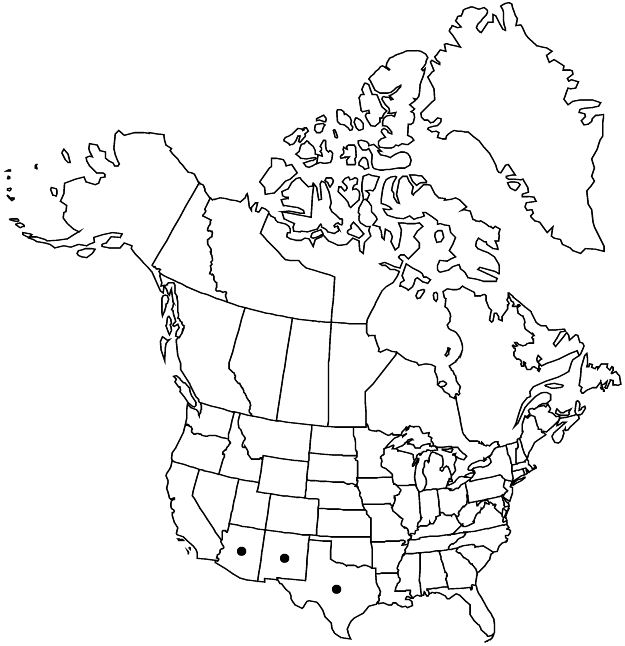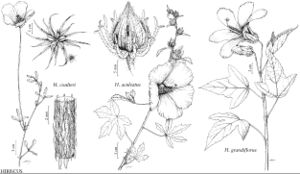Hibiscus coulteri
Smithsonian Contr. Knowl. 3(5): 23. 1852.
Subshrubs, to 2 m, herbage with appressed-stellate and simple hairs throughout. Stems: stellate hairs of younger stems dense, appressed, 4-armed, arms approximate in pairs, aligned with stem axis, lines of fine, curved hairs absent or obscured; older growth grayish, rough, glabrescent. Leaves: stipules linear-subulate, 3–10 mm; petiole primarily in distal 1/2, sometimes themselves shallowly pinnately lobed, surfaces scabridulous, hairs appressed-stellate, obscure nectary present abaxially on midvein near base. Inflorescences solitary flowers in axils of distal leaves. Pedicels jointed below apices, to 17 cm, usually much exceeding subtending leaves; involucellar bractlets 8–14, linear-subulate, 1–2 cm, margins ciliate. Flowers erect or ascending; calyx divided 3/4+ length, funnelform, 1.4–2.2 cm, equaling or slightly exceeding involucel, lobes narrowly lanceolate-triangular, margins ciliate, apices attenuate, nectaries absent; corolla rotate, petals yellow to cream, usually with dark to obscure maroon lines basally, asymmetrically obovate to broadly obovate, 1.6–4 × 1–3.5 cm, margins ± entire, sparingly hairy abaxially where exposed in bud; staminal column straight, yellow or cream, 0.6–1.4 cm, bearing filaments throughout, free portion of filaments not secund, 1–3 mm; pollen yellow-orange; styles cream, 1.5–5 mm; stigmas maroon or cream. Capsules pale olivaceous gray with darker median stripe on each valve, ovoid or ellipsoid, 0.7–1.7 cm, to 2/3 calyces, apex rounded, hairy near apex or glabrous throughout. Seeds dark brown, angulately reniform-ovoid, 2.4–3 mm, silky-hairy ± throughout.
Phenology: Flowering nearly year-round.
Habitat: Desert, rocky slopes
Elevation: 600–1600 m
Distribution

Ariz., N.Mex., Tex., Mexico (Baja California, Chihuahua, Coahuila, Durango, Nuevo León, Sonora, Zacatecas).
Discussion
Hibiscus coulteri has been recorded in the southern half of Arizona; in Otero County, New Mexico; and in the region west of the Pecos River in Texas.
A naturally occurring hybrid between Hibiscus coulteri and H. denudatus (Hibiscus ×sabei Weckesser) has recently been documented from western Texas (W. Weckesser 2011).
Selected References
None.
